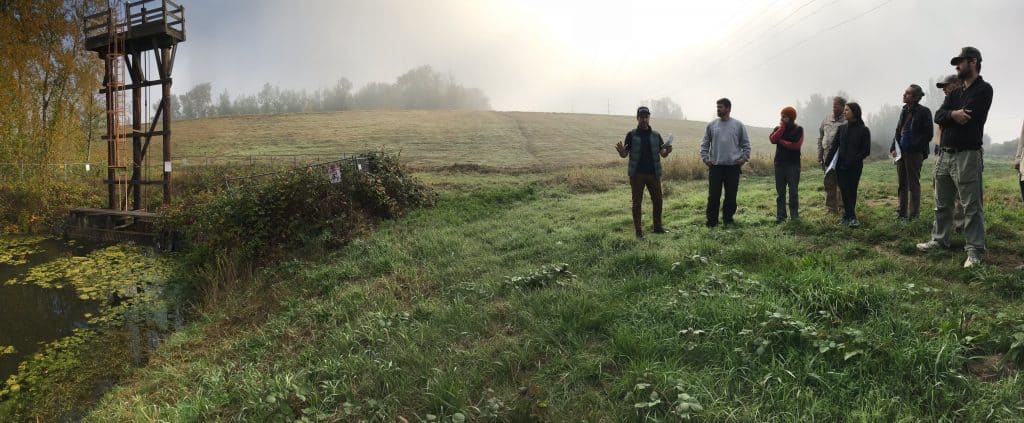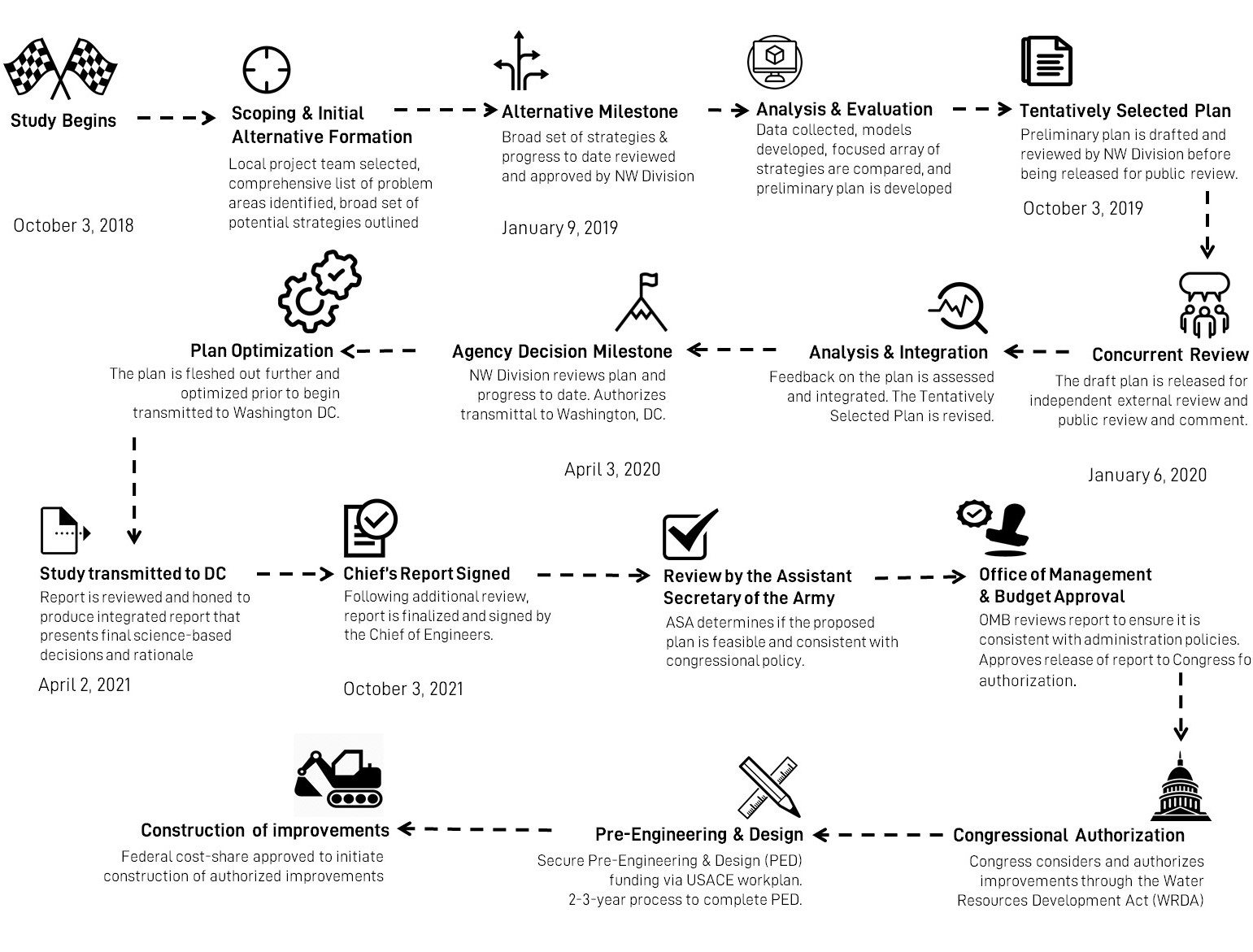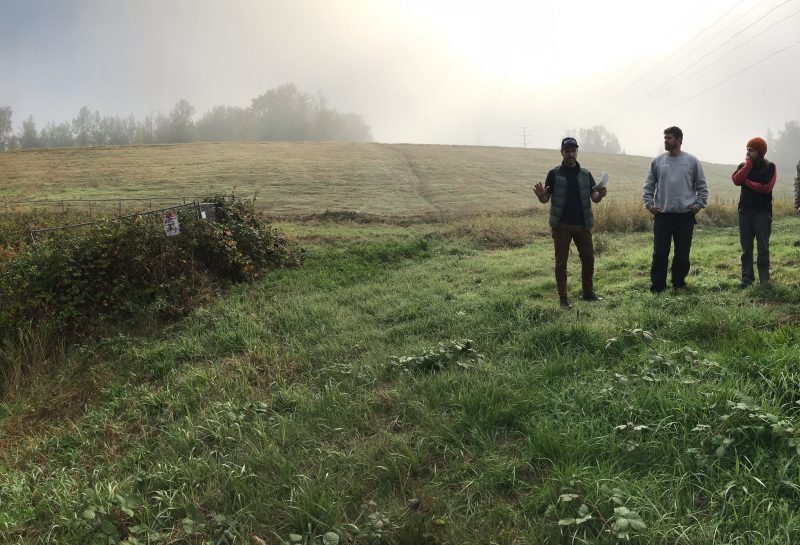As we’ve worked to identify ways to modernize our infrastructure, we learned that the best pathway to secure federal funding for levee improvements is to partner with the US Army Corps of Engineers (USACE) on a New Start Feasibility Study.

US Army Corps of Engineers Feasibility Study
of the Portland Metro Levee SystemCurrent
US Army Corps of Engineers Feasibility Study
Thanks to the help of our Congressional Delegation and our partners with Levee Ready Columbia (LRC), we successfully advocated for congressional designation of a New Start Feasibility Study in mid-2018. The Corps’ formal three-year process was completed in August 2021 – culminating with the signing of the Chief’s Report by the Chief Engineer of the Corps in Washington, D.C. Read the press release here.
This study was an important opportunity to bring expertise and federal funds to our area and it puts us on a pathway to receive federal help in making the repairs and improvements that are needed to ensure the levees and conveyance infrastructure meet federal safety standards and continue to provide reduced flood-risk for communities, property, and the environment.

For the last several years, USACE feasibility studies have been guided by what the Corps calls their “3 x 3 x 3 rule.” This means that all studies must take no more than three years to complete, cost no more than $3 million, and must involve regular review at all three levels of the USACE – district, division, and headquarters. This format was established to help keep these studies moving forward and to ensure there aren’t any major delays when it comes time to deliver the recommendations to Congress. Below is a high-level overview of the study’s major milestones.

The funding for this study came from a special appropriation package for USACE to work specifically on flood and storm damage reduction projects. Because of this special appropriation, the study is 100% federally funded and does not require any local match. It also means that USACE must focus exclusively on issues related to flood safety in their study. Although the allotted funding goes directly to the USACE, their investigation and modeling will greatly benefit our local efforts, and their recommendations may result in some federal funding for the repairs needed to our local levee system. We are working closely with USACE throughout the process to contribute to their recommendations, integrate local priorities, and fully maximize the opportunity.
We are hopeful that this process will culminate in some federal re-investment in our system but do not expect that it will be enough to complete all the work that is needed to recertify and modernize the system. For this reason, we will continue our efforts at the local level to complete the projects that are not included in the Feasibility Study and must be completed to recertify the levee system through the Federal Emergency Management Agency, and continue to work to develop a more modern and sustainable way to support the flood safety infrastructure going forward through the creation of the Urban Flood Safety & Water Quality District.
The Feasibility Study continues to be a critical opportunity to bring federal funds and expertise to the table to help make the necessary repairs and improvements to our levees. Without this opportunity, we would have to find a way for all the necessary repairs and improvements to be paid for by Oregonians, which would be a very difficult lift that would take a much longer time, putting our communities at risk each winter, spring and fall.
In late August 2021, the head of the US Army Corps of Engineers signed the “Chief’s Report,” approving the final Integrated Feasibility Report & Environmental Assessment, which details the analysis completed by the Corps, the vulnerabilities identified within the levee system, the potential solutions that were considered, the final array of alternatives that were evaluated, and the alternative that was selected as the “Recommended Plan.” A mostly final draft of the report is available on the Corps’ website. The final report will be published online and on the federal register later this year.
The following resources were created in January 2020, following the Corps’ release of the Draft Tentatively Selected Plan. An updated set of summary materials featuring the Recommended Plan will be available later this year:
READER’S GUIDE | MAPS OF THE ALTERNATIVES | PUBLIC MEETING SLIDES
Following the public comment period in January 2020, the Corps went through a process of refining the Tentatively Selected Plan, during which more technical analysis and other changes were made as they worked with the drainage districts (as the local sponsors) to address comments received, including community concerns, to the fullest extent possible and allowable under USACE policies and federal laws.
During this webinar, the chat function was used to submit questions that our moderator would ask the panelists to address as time allowed. A transcript of the chat from the meeting is available here. We are working with USACE to provide written responses to these questions and other frequently asked questions about the feasibility study by the end of November. More to come!
The Boards of PEN 1, PEN 2, MCDD, and SDIC have been asked to provide a letter of endorsement to include with the final report when it goes to USACE’s Headquarters in Washington, DC for final review in April 2021. To this end, the Boards will be working to make a decision about endorsing the results of the study by March 2021.
If the report is endorsed by the Drainage District Boards and then finalized and approved by USACE’s Chief of Engineers, it will go on for more evaluation by the Assistant Secretary of the Army (ASA) and the White House Office of Management & Budget (OMB). OMB will ultimately decide if the recommendations in the study should move forward for authorization by Congress as a part of the reauthorization of the Water Resources Development Act (WRDA). WRDA reauthorization generally occurs every two years these days, so even if the study results are not included in WRDA 2022, there may be future opportunities to advance the results of the study in a future reauthorization.
We hope to be able to hold another community update in the late summer or fall of 2021
FEEDBACK
Date
March 17, 2020




No Comments
Sorry, the comment form is closed at this time.